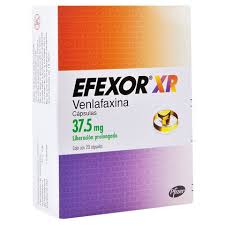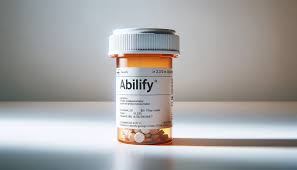Effexor
Effexor (venlafaxine), encompassing its pharmacological profile, comprehensive side effects, usage considerations, and beyond.
Pharmacological Profile of Effexor (Venlafaxine)
Effexor (venlafaxine) is elegantly categorized as a serotonin-norepinephrine reuptake inhibitor (SNRI). This class of medications operates primarily through:
Inhibition of serotonin (5-HT) reuptake: This mechanism enhances the availability of serotonin within the brain, a vital neurotransmitter that significantly influences mood stabilization, anxiety management, and overall emotional health.
Inhibition of norepinephrine (NE) reuptake: Norepinephrine is integral to alertness, arousal, and focus, and it also plays a role in mood regulation. By obstructing its reuptake, venlafaxine amplifies its presence.
This dual mechanism targeting both serotonin and norepinephrine sets SNRIs apart from selective serotonin reuptake inhibitors (SSRIs), which focus solely on serotonin.
At lower to moderate dosages, venlafaxine primarily inhibits serotonin reuptake. However, as the dosage escalates, its influence on norepinephrine reuptake becomes increasingly significant. This unique property may render venlafaxine particularly effective in addressing both depressive and anxiety disorders, as well as conditions associated with pain, such as fibromyalgia or diabetic neuropathy (noting that these applications are considered off-label).
Comprehensive Dosage Insights
Immediate-release versus Extended-release:
The immediate-release formulation (Effexor) necessitates multiple daily doses owing to its relatively brief half-life of approximately 5 hours. In contrast, the extended-release formulation (Effexor XR) is crafted for once-daily administration, boasting a longer half-life of around 11 hours, which ensures more stable concentrations of the medication within the bloodstream.
Initial Dosing Guidelines:
For Depression:
Immediate-release typically commences at 75 mg per day, distributed across two or three doses.
Extended-release initiates at 37.5 mg per day, with a gradual increase thereafter.
For Anxiety Disorders (GAD, SAD):
The extended-release form begins at 37.5 mg per day, often escalating to 75 mg per day after one week.
For Panic Disorder:
The initial dose is generally set at 37.5 mg per day, with potential increases up to 225 mg per day, tailored according to individual tolerance and clinical response.
Maximum Dosage Recommendations:
For Immediate-release: A maximum of 375 mg per day is typically advised.
For Extended-release: The upper limit is generally 225 mg per day.
Side Effects (In-Depth)
While Effexor is predominantly well-tolerated, it may elicit a spectrum of side effects that can differ based on dosage and individual reactions. These side effects can be categorized into common and serious types.
Common Side Effects:
Nausea: This is frequently encountered in the early stages, particularly when initiating the medication or adjusting the dosage. Fortunately, it often diminishes with time.
Headache: A notable number of individuals report experiencing headaches, especially during the initial phase of adjustment.
Dry mouth: A decrease in saliva production may lead to discomfort, although this symptom may gradually improve.
Sweating: Some individuals may experience excessive perspiration (hyperhidrosis).
Fatigue or Drowsiness: Certain users may feel an overwhelming sense of tiredness or sleepiness, particularly at elevated doses.
Insomnia: Challenges with falling or staying asleep are more prevalent among those using the immediate-release formulation.
Loss of appetite: This may stem from the overall effects on mood or gastrointestinal disturbances.
Serious Side Effects:
Increased blood pressure:
Effexor has the potential to elevate both systolic and diastolic blood pressure, especially at doses exceeding 300 mg per day. It is advisable to monitor blood pressure regularly, and should any elevation be noted, a reduction in dosage or cessation of the medication may be warranted.
Serotonin syndrome:
This serious condition arises from an excess of serotonin and can be life-threatening. Symptoms may include agitation, hallucinations, fever, excessive sweating, shivering, rapid heartbeat, muscle rigidity, and impaired coordination. Serotonin syndrome is particularly likely when venlafaxine is used in conjunction with other serotonin-enhancing medications, such as SSRIs, SNRIs, triptans for migraines, or certain herbal supplements like St. John’s Wort.
Risk of suicide:
As with all antidepressants, Effexor carries a significant warning regarding the potential for suicidal thoughts and behaviors, especially in children, adolescents, and young adults under 25. Vigilant monitoring for any sudden shifts in mood or worsening depression is essential.
Withdrawal symptoms:
Abruptly discontinuing Effexor can lead to discontinuation syndrome, a common concern. Symptoms may encompass dizziness, headaches, fatigue, irritability, flu-like sensations, and “brain zaps,” which are akin to electric shocks in the head.
Interactions with Other Medications
Effexor has the potential to engage with a range of pharmaceuticals, which may elevate the risk of adverse reactions or diminish the efficacy of treatment:
Other antidepressants: The concurrent use of Effexor with SSRIs, MAOIs, or other SNRIs can heighten the likelihood of serotonin syndrome.
Monoamine oxidase inhibitors (MAOIs): The combination of MAOIs with Effexor is strictly contraindicated due to the risk of severe interactions, which could lead to a hypertensive crisis characterized by dangerously high blood pressure.
Anticoagulants: Effexor may amplify the risk of bleeding, particularly when used alongside blood thinners such as warfarin.
Alcohol: Although alcohol does not directly create a toxic interaction with Effexor, their combination can exacerbate certain side effects, including dizziness, drowsiness, and impaired concentration.
Stimulants: Caution is advised when using stimulants like amphetamines in conjunction with Effexor, as they may lead to excessive increases in blood pressure or heart rate.

Special Considerations
Pregnancy and breastfeeding: There are significant concerns regarding the effects of Effexor during pregnancy. It may lead to complications such as neonatal withdrawal syndrome if administered in the third trimester, alongside potential risks to fetal development. Typically, it is prescribed only when the benefits are deemed to outweigh the risks. Effexor is also present in breast milk, necessitating a discussion with a healthcare provider regarding breastfeeding while on this medication.
Elderly population: Older individuals may exhibit heightened sensitivity to the blood pressure-raising effects of Effexor, prompting recommendations for lower dosages.
Kidney and liver function: As Effexor is metabolized in the liver and eliminated by the kidneys, those with liver or kidney impairments may require dosage adjustments or more frequent monitoring.
Efficacy and Duration of Treatment
Effector has demonstrated considerable efficacy in the control of major depressive disorderliness, anxiety disorders, and panic a shambles. However, individuals may require a span of 4 to 6 weeks to fully experience its therapeutic benefits, with some cases necessitating an even longer duration, contingent upon individual response. It is predominant to note that prolonged use may lead to a growth/become smaller in effectiveness as tolerance develops.
Discontinuation of Effector: Abrupt cessation of Effector is ill-advised, particularly following extended use, due to the risk of withdrawal symptoms. Physicians generally recommend a gradual reduction in dosage to alleviate these potential effects.
In Summary
Effector (venlafaxine) stands as a formidable option in the pharmacological treatment of depression, anxiety, and panic disorderliness. While it can yield significant benefits, it is accompanied by the possibility of side effects, withdrawal challenges, and interactions with other medications. Consistent consultations with a healthcare professional are essential to ensure optimal efficacy and to mitigate any associated risks.







